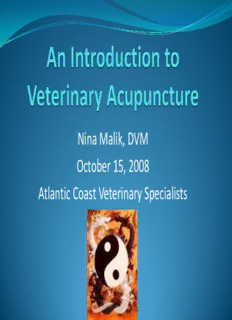
Nina Malik, DVM October 15, 2008 Atlantic Coast Veterinary PDF
Preview Nina Malik, DVM October 15, 2008 Atlantic Coast Veterinary
Nina Malik, DVM October 15, 2008 Atlantic Coast Veterinary Specialists •History of Acupuncture •Eastern Framework •Western Framework- Mechanism of Action •Acupuncture Modalities •Indications for Acupuncture •Case Studies What We Learn Curriculum in Veterinary Medicine Graduation Requirements First Year Cr. Fall 5 Principles of Morphology I—B M S 330 6 Biomedical Sciences I—B M S 333 3 Physiological Chemistry— BBMB 420 1 Clinical Foundations—B M S/V C S 339 1 Clinical Imaging I—V C S 391 1 Case Study I—B M S 345 R Veterinarian in Society I—V C S 311 17 Cr. Spring 4 Principles of Morphology II—B M S 331 6 Biomedical Sciences II—B M S 334 3 Neurobiology—B M S 337 2 Veterinary Immunology—V MPM 380 2 General Pathology—V Pth 342 1 Case Study II—B M S 346 1 Veterinarian in Society II—V C S 312 19 Second Year Cr. Fall 4 Veterinary Parasitology—V Pth 376 3 Systemic Pathology—V Pth 372 5 Veterinary Microbiology I—V MPM 386 2 Case Study III—V Pth 377 1 Veterinarian in Society III—V C S 313 15 Cr. Spring 3 General Pharmacology—B M S 354 1 Anesthesiology—VCS 398 3 Veterinary Microbiology II—V MPM 387 3 Public Health—V MPM 388 6 Principles of Surgery—V C S 397 2 Case Study IV—V MPM 378 18 Third Year Cr. Fall 3 Clinical Path—V Pth 425 2 Infert. Diseases—V MPM 436 5 Clinical Medicine I—V C S 444 3 Surgery Laboratory—V C S 449 4 Disturbances of Reproduction—V C S 450/VDPAM 450 3 Pharmacology and Therapeutics—B M S 443 1 Veterinarian in Society IV—V C S 314 R Introduction to Clinics—V C S 440/VDPAM 440 R Seminar—V C S 385 21 Cr. Spring 4 Special Pathology—V Pth 422 3 Infectious Diseases and Preventive Medicine—V MPM 437 5 Clinical Medicine II—V C S 445/VDPAM 445 3 Veterinary Toxicology—VDPAM 426 2 Radiology—V C S 448 1 Ophthalmology—V C S 399 1 Veterinarian in Society—V C S 315 R Seminar—V C S 385 18 Fourth Year The fourth year of the veterinary medical curriculum is designed to be flexible and to provide for species emphasis. Students must complete 38 credits during their fourth year. They must take a required block and at least one option block. The remainder of the fourth year credits are acquired by selecting additional option blocks, Veterinary Teaching Hospital clinical electives, off-campus clinical electives, or other electives. Additional off-campus clinical elective credits can be earned at approved government agencies, research laboratories, veterinary practices, and other university hospitals. Indications Applications Mechanisms of action Journal of the American Veterinary Medical Association September 15, 2007, Vol. 231, No. 6, Pages 913-918 Abstract Evaluation of electroacupuncture treatment for thoracolumbar intervertebral disk disease in dogs Ayne Murata Hayashi, DVM, MSc, Julia Maria Matera, DVM, PhD, Ana Carolina Brandão de Campos Fonseca Pinto, DVM, PhD Department of Surgery, School of Veterinary Medicine, University of São Paulo, São Paulo-SP, Brazil 05508-900. (Hayashi, Matera, de Campos Fonseca Pinto) Conclusions and Clinical Relevance—Electroacupuncture combined with standard Western medical treatment was effective and resulted in shorter time to recover ambulation and deep pain perception than did use of Western treatment alone in dogs with signs of thoracolumbar intervertebral disk disease. What do these athletes have in common? Ancient Healing Art Theories of circulation and pulse character postulated in China 4,000 years before Western medicine Various nations claimed to be founders Founders of acupuncture- Northern India or Tibet (Ayurvedic Medicine?) Huang-de-nei-jing First written record of acupuncture over 2,200 years ago in China Two books- Suwen is the most famous Conversation with Yellow Emperor (3rd millennium B.C.) Physiology, pathology, diagnosis, and prevention of disease Authorship- Yellow Emperor? History of Veterinary Acupuncture First Veterinary Acupuncture Textbook Sun-Yang, 650 B.C. Lyon, France, 1761
Description: